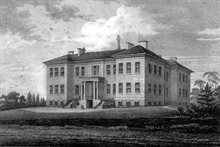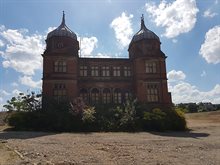The Derbyshire Royal Infirmary (DRI - known until 1890 as the Derbyshire General Infirmary) was first built in 1810. Its construction was overseen by the Derbyshire cotton manufacturer William Strutt, whose priority was to ensure the building was fireproof (as this article by Paul Elliott explains). This connection highlights the overlap between utilitarian industry and the practice of medical care in 19th century Derbyshire, a connection further illustrated by Nightingale’s own story.
The mortality rate in the hospital was initially relatively low, but rose to 5-6% after 1830. In the 1860s, Dr William Ogle, the hospital’s superintendent, corresponded at length with Nightingale as to how it should be redesigned. This resulted in a complete rebuild of the hospital, designed by Henry Isaac Stevens. The new building opened in 1869 with a new wing named after Nightingale.
However, in 1890 there was an outbreak of typhoid at the hospital. A subsequent inspection caused the old building to be condemned and rebuilt. Queen Victoria laid the foundation stone for the new building on a visit to Derby in 1891.
The DRI Site Today
The DRI closed as a hospital in 2009. Plans were released in 2013 to redevelop the old DRI site for housing, with the area to become known as the ‘Nightingale Quarter’. An outline planning application for the £40 million-plus scheme was approved by Derby city councillors in 2017, after the plans were changed to ensure that both “pepper pot” buildings from the original DRI would be retained. This followed a petition, signed by thousands of residents, to preserve the "pepper pots" from destruction, as reported by the Derby Telegraph.

'View of the Derbyshire General Infirmary', printed in Charles Sylvester, The Philosophy of Domestic Economy (Nottingham: Barnett, 1819), Wellcome Collection.

DRI 'Pepper Pots', photo by Kelly, Wikimedia commons